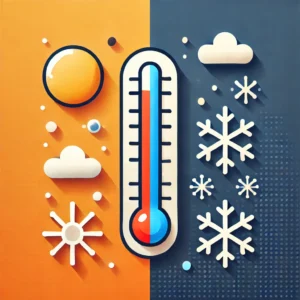A new global study has found that more than 60% of the planet has likely experienced abrupt “temperature flips” rapid shifts between extreme heat and cold since 1961, with their frequency and intensity projected to increase significantly by the end of the century due to climate change.

Published in Nature Communications, the research reveals how these sudden and intense weather swings unlike individual heatwaves or cold spells offer little time for humans, wildlife, and ecosystems to adapt. The impacts can be devastating, from health complications to crop failures and infrastructural stress.
One such flip occurred in April 2021 in Europe where temperatures fell dramatically after an unusually warm spell, damaging crops due to frost. These rapid transitions pose risks to both human well-being and critical sectors like agriculture and energy. Scientists argue that the limited research and awareness around these temperature swings is alarming, especially as the world warms.
The study, which analysed global data between 1961 and 2023, shows that temperature flips are most common in the mid-latitudes including East Asia, parts of Africa, South America, eastern North America, and Australia. Regions that experience more frequent flips also tend to suffer more intense ones. Asia, especially densely populated areas in South and Southeast Asia, is particularly vulnerable.
Researchers linked this phenomenon to the behaviour of Rossby waves, large-scale atmospheric patterns that distribute heat globally. These waves can drive unpredictable weather changes, increasing the chances of temperature flips.
Looking ahead, climate models project a 7-8% increase in the frequency of temperature flips by 2100, compared to pre-1990 levels. The intensity is expected to rise by over 7%, while the duration between warm and cold phases could shorten by up to 3%.
This means less time for energy systems to adapt, especially in lower-income nations. The study estimates that low-income countries could face exposure levels 4 to 6.5 times higher than the global average, putting immense pressure on already strained infrastructure and health systems.
How Temperature Flips Threaten Economies
- Energy demands spike unpredictably, straining power grids, especially in low-resource regions.
- Agricultural damage from frost after warm periods can lead to food insecurity and economic losses.
- Public health risks rise with greater exposure to both heat and cold extremes, increasing mortality and healthcare costs.
- Workforce productivity drops as thermal discomfort affects outdoor and manual labor sectors.
- Insurance claims and disaster recovery costs increase, burdening governments and private sectors alike.
As the planet continues to warm, researchers call for urgent climate mitigation strategies and policy interventions to reduce emissions and better prepare for these increasingly frequent temperature swings.
